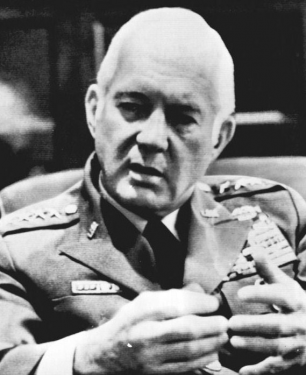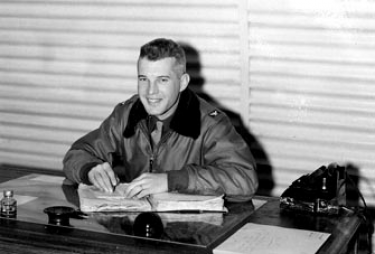
 |
|
|
||
|
John Hersey Michaelis 'Iron Mike' |
||||
|
Graduate, U.S. Military Academy, Class of 1936 Engagements: • World War II (1941 - 1945)• Korean War (1950 - 1953) |
||||
| Biography: | ||||
|
John Hersey Michaelis John Hersey Michaelis was born on 20 August 1912 at the Presidio of San Francisco, CA. He graduated from high school in Pennsylvania in 1931 and enlisted in the Army as a private. After serving as an infantryman, he was admitted to the U. S. Military Academy. Michaelis graduated with the Class of 1936 and served in the Army during World War II and Korea. World War II As a Lieutenant Colonel in World War II, he was Executive Officer of the 502nd Parachute Infantry Regiment of the 101st Airborne Division, but took command of the unit on 9 June 1944 after the commanding officer, Colonel George Van Horn Moseley, Jr., broke his leg on the jump into Normandy. Michaelis later led his Regiment in an airborne assault on Holland, during which he was wounded twice and had to relinquish command of the 502nd to LTC Steve A. Chappuis. After recovering from his wounds, Michaelis returned to active duty in December 1944 as Chief of Staff of the 101st Airborne Division until the end of the war. In 1945, Michaelis was assigned to the War Department General Staff, where he rose to Senior Aide-de-Camp to Army Chief of Staff General Dwight Eisenhower during 1947-48. [He reverted to the rank of lieutenant colonel for that duty, but was publicly praised by Eisenhower as one of four lieutenant colonels in the Army 'of extraordinary ability.'] Korean War As a Lieutenant Colonel at the beginning of the Korean War, Michaelis commanded the famed 27th Infantry ('Wolfhound') Regiment (1950-51) which held off North Korean armies at the Pusan perimeter while U.S. forces massed for a crushing breakthrough. This action became known as the 'Battle of the Bowling Alley' and earned the 27th its second Presidential Unit Citation. As an exemplary and tough leader, Michaelis earned the name 'Iron Mike' from his men. Michaelis famously told his men, "Remember, you're here to kill, and not to be killed." During his command of the 27th, Michaelis received two battlefield promotions within six months, to full colonel and to brigadier general; he also received the Distinguished Service Cross. War: At the Bowling Alley; Time Magazine, 4 September 1950 In a month of almost continuous action, the U.S. 27th ("Wolfhound") Regiment of the 25th Infantry Division had never retreated unless it was ordered by higher command, and most of the professionals on the Korean front thought they knew the reason why: the 27th Regiment had something no other outfit had. That something was its commander, a lean, pleasantly hard-bitten West Pointer named John Hersey Michaelis, 38. Last week, the men of Colonel Michaelis' 27th combat team tangled with a capable and battle-tested foe, a 45-year-old North Korean lieutenant general named Kim Mu Chong, onetime commanding general of the Chinese Communists' famed Eighth Route Army. Kim's men met "Mike" Michaelis' men at a road junction 15 miles northwest of Taegu. General Kim looked the situation over and decided to hit young Colonel Michaelis smack in the nose. Armored Slam. For four nights running, Kim slammed his armor at Michaelis' forward elements astride the road just south of the junction. The Red tanks would drive down the road to within 100 yards of the first U.S. foxhole and open flat trajectory fire with their 85-mm. guns; a good many of the shells went screaming down the road, hit the first small elevation in their path and bounced into a nearby hillside, like bowling balls. Michaelis' men, who did not budge under the assault, nicknamed the road, "the bowling alley." Finally, General Kim stopped bowling. Instead of trying to take the road headon, he tried to cut it off by an enveloping thrust. Kim sent his 8th Regiment through a hole in the South Korean line on Michaelis' right flank. "He's trying to cut the road to Taegu," said grey-haired Mike Michaelis as he sat, bone-tired, against the wall of his culvert command post as automatic weapon fire zinged and buzzed like angry bees around him. "He's trying to scare me into withdrawing and leaving my equipment. Then he can come down the road with his armor. I'm just not going to do it." Big or Dead. Michaelis (rhymes with quick hail us) had been in tight spots before. He took part in the Normandy assault, won a battlefield promotion to full colonel. During the airborne invasion of Holland in September 1944, he jumped at the head of the 502nd Parachute Infantry Regiment of the 101st Airborne Division, was wounded twice in three days. During the Battle of the Bulge, he was chief of staff of the 101st. When he arrived in Korea to take command of the 27th, Michaelis had reverted to the rank of lieutenant colonel. A few days later, he had won his second battlefield promotion to full colonel. This time it looked as if he would keep his silver eagles. Said one of his sergeants thoughtfully: "The colonel, he's going to be a big man in this Army - or a dead one." Kim Mu Chong discovered what Michaelis' men knew - the colonel was a hard man to scare. In the face of Kim's enveloping move, Mike sat tight and blasted away with his expertly placed artillery. He had some bad moments when his artillery fire control center, directing four batteries, suffered a direct mortar hit that killed his best fire control personnel. But under Mike Michaelis' skillful direction the batteries continued to fire. Just when the situation looked the blackest on his right flank, Michaelis got two badly-needed battalions of reinforcements. Then, at nightfall, a minor miracle roared out of the northwest sky. A flight of seven B-26s, fully loaded with bombs, came winging in. They had been unable to find their primary target, asked a spotter plane over the embattled 27th Regiment if he had any job for them. He certainly did. The spotter guided the B-26s-with only enough gas in their tanks to stay in the air 20 minutes - to General Kim's 8th Regiment, just as it prepared for a night assault. Down thundered 20 tons of bombs. Later reconnaissance showed that the slaughter among the Reds had been tremendous. Mike Michaelis' artillery, with a nice assist from the B-26s, had broken Kim's drive. The Big Picture. This story of how brilliant young Colonel Michaelis beat off General Kim's assault is what the working soldier on the hills, behind the road blocks and in the ditches calls the "big picture." War: One Star for Mike; Time Magazine, 5 March 1951 "He'll either be a general or a dead colonel," cracked G.I.s last summer about the hottest regimental commander among U.N. forces in Korea. At Taegu's bloody "bowling alley," John Hersey Michaelis (rhymes with regale us), better known as "Mike," and his redoubtable 27th Infantry (Wolfhound) Regiment, now better known as "The Fire Brigade," fought bravely and brilliantly to help hold the Pusan perimeter. Sinewy Mike Michaelis won a battlefield promotion to full colonel, and the D.S.C. [Army Distinguished Service Cross] for "extraordinary heroism" under fire. It was the second time West Pointer Michaelis had won a temporary eagle. In World War II, he jumped with the 502nd Parachute Infantry of the 101st Division on the Normandy beachhead, took command when his superior was killed [his leg was broken; he did not die], won battlefield promotion to colonel. He was wounded twice in Holland, but managed to leave the hospital in time for the Battle of the Bulge. After the war, he was Aide to Chief of Staff Dwight Eisenhower. On leaving the Pentagon, Ike wrote Mike how proud he had been to "have had as aide a sterling young combat officer . . ." Last week the sterling combat officer, now 38, was promoted to brigadier general. His new job in Korea: Assistant Commander of the 25th Division, of which his 27th Infantry is a part. Post-War Service After returning from Korea, Michaelis became Commandant of Cadets at the U.S. Military Academy at West Point from 1952-54. Other commands included V Corps from May 1962 - July 1963; he later commanded the 5th Army at Ft. Sheridan, IL, where many Vietnam recruits were trained. Michaelis received his fourth star on 1 October 1969 and became Commander-in-Chief, United Nations Command (CINCUNC); Commander, U.S. Forces Korea (COMUSFK); and Commanding General, Eighth U.S. Army (CGEUSA), 1969-72. General Michaelis retired from active duty in 1972. Medals, Awards and Badges Distinguished Service Cross He also received many other medals and awards from foreign countries. Distinguished Service Cross Citation The President of the United States of America, under the provisions of the Act of Congress approved July 9, 1918, takes pleasure in presenting the Distinguished Service Cross to Colonel (Infantry) John Hersey Michaelis (ASN: 0-20328), United States Army, for extraordinary heroism in connection with military operations against an armed enemy of the United Nations while serving as Commanding Officer of the 27th Infantry Regiment, 25th Infantry Division. Colonel Michaelis distinguished himself by extraordinary heroism in action against enemy aggressor forces in the Republic of Korea near Sinsen-ni, Korea, on 3 September 1950. On that date, Colonel Michaelis' regiment launched an assault against heavily fortified enemy positions. While the attack was in progress Colonel Michaelis, although all avenues of approach were under heavy mortar and sniper fire, walked forward form the Regimental Command Post to personally determine the tactical situation. During this period the enemy launched a determined counterattack, penetrating the forward elements and forcing the Command Post group to take shelter in a culvert. Colonel Michaelis, despite heavy fire, remained in the open until he had made a complete estimate of the situation; then retiring to the culvert, he attempted to contact the Regimental command Post for support but communications were out. Without regard for his own personal safety, Colonel Michaelis, disregarding the heavy mortar and sniper fire, made his way to the Regimental Command Post where he called for an air strike on the enemy position. The air strike was successful, causing the enemy to withdraw in disorder and permitting the 3d Battalion to take its objective. General Orders: Headquarters, Eighth U.S. Army, Korea: General Orders No. 96 (October 4, 1950) Death and Burial General John Hersey Michaelis died of heart failure on Thursday, 31 October 1985, at Rabun County Hospital in Clayton, GA. He is buried at Arlington National Cemetery in Arlington, VA. |
||||
| Origin of Nickname/Handle: | ||||
|
He was awarded the name by his men because he was such an exemplary and strong leader. In the Korean War his men remarked that "He'll either be a general or a dead colonel." |
||||
| Honoree ID: 290 | Created by: MHOH | |||
Ribbons
Medals
Badges
Honoree Photos
 |  |  |
 |  |
 |


